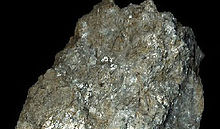Type a search term to find related articles by LIMS subject matter experts gathered from the most trusted and dynamic collaboration tools in the laboratory informatics industry.

Sericite is the name given to very fine, ragged grains and aggregates of white (colourless) micas, typically made of muscovite, illite, or paragonite.[1] Sericite is produced by the alteration of orthoclase or plagioclase feldspars in areas that have been subjected to hydrothermal alteration (also see Sericitic alteration) typically associated with copper, tin, or other hydrothermal ore deposits. Sericite also occurs as the fine mica that gives the sheen to phyllite and schistose metamorphic rocks.
The name comes from Latin sericus, meaning "silken" in reference to the location from which silk was first utilized, which in turn refers to the silky sheen of rocks with abundant sericite.